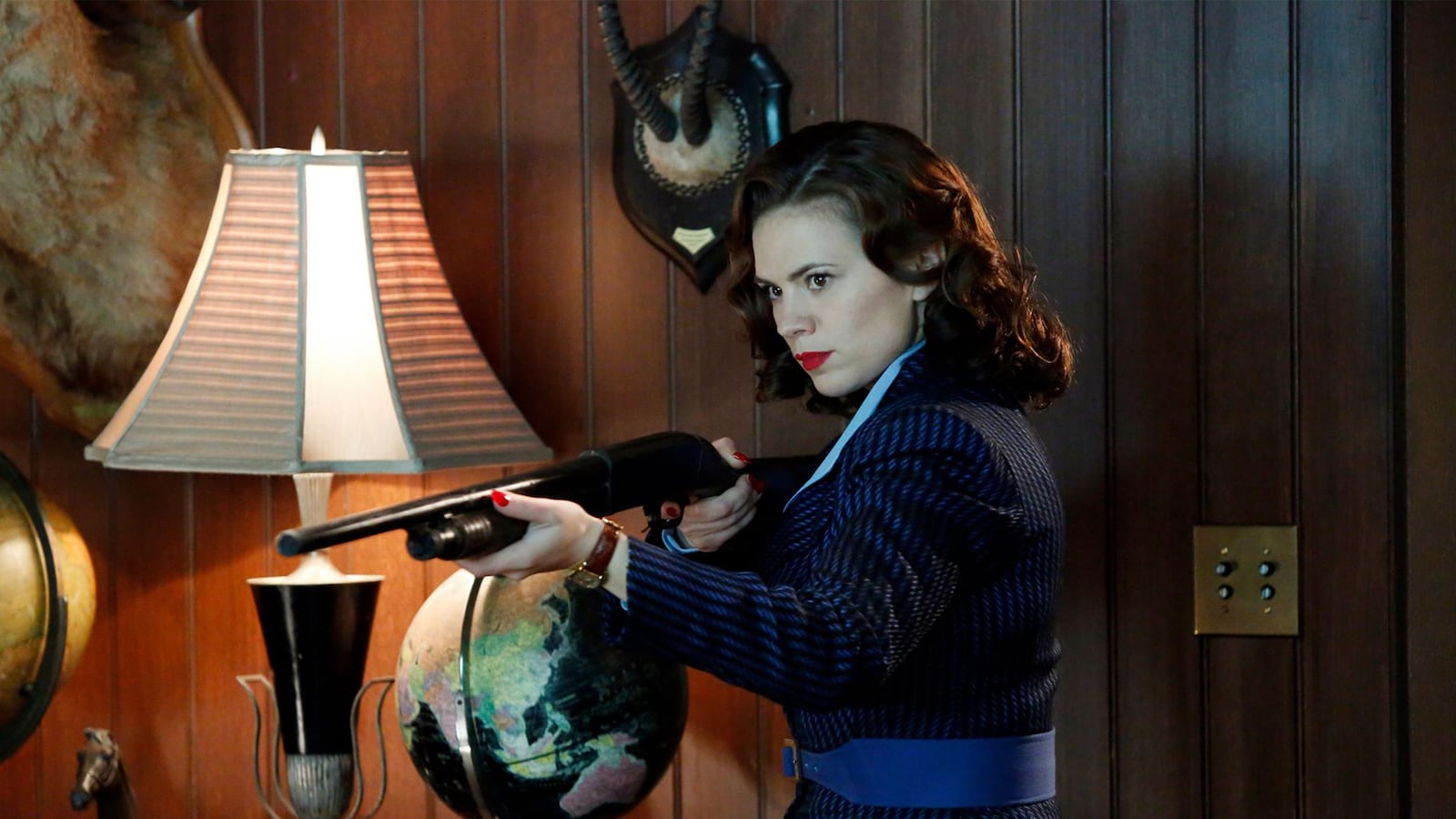Marvel has become such a dominant film presence that the company’s robust motion picture slate has been planned out through 2019. While its TV division hasn’t been nearly as successful yet, it’s quickly making up for lost time, with a pair of ABC series—Marvel’s Agents of S.H.I.E.L.D. and now Marvel’s Agent Carter, which wrapped its eight-episode first season Tuesday night—and five upcoming shows set for Netflix, kicking off with Marvel’s Daredevil on April 10.
The company is also trying to close the gap with rival DC, which has a number of successful series itself—including The Flash, Gotham, and Arrow, with the terrific iZombie on tap for March and Supergirl already lined up for CBS next season. The man at the center of it all is Jeph Loeb, who as head of television oversees and executive produces all Marvel’s TV projects. In the space of a year, “to go from one show to four shows that are going simultaneously, I do consider myself quite lucky,” says Loeb.
Now he’s waiting on ABC to decide on the fate of Agent Carter, which followed Peggy Carter (Hayley Atwell) after the events of Captain America: The First Avenger and the end of World War II, where she worked for the Strategic Scientific Reserve (S.S.R.) while going on secret missions for Howard Stark (whose son Tony would become Iron Man). If the show gets a second year, Loeb hopes it will become more than a bridge between the two halves of Agents of S.H.I.E.L.D.’s season, as was the case this season.
“That’s really ABC’s decision, not ours,” says Loeb. “We came up with this idea of 30 hours of Marvel, as opposed to thinking about them as separate shows. That idea we would very much like to continue, but our hope now is that Carter has proven itself in such a way that maybe this will be another show that would be in a different time slot. And that would be great.”
Unlike Agents of S.H.I.E.L.D., which has never included any Marvel movie footage, Carter began with a clip from The First Avenger, featuring Steve Rogers (Chris Evans) saying goodbye to girlfriend Peggy Carter. “I think it was Joss [Whedon, S.H.I.E.L.D.’s co-creator and writer-director of both Avengers films] that said it best, which is we like our Easter eggs, but we don’t want it to be an Easter egg farm. So whenever we do borrow something from the studio we want to make sure that it has real power and empathy and really lives in that world. It’s very hard to tell Peggy’s story without understanding her relationship with Steve Rogers,” says Loeb. “So being able to see those moments from the film I think actually helped the show as opposed to just having Tony Stark fly by.”
From its outset, Agent Carter received a much more enthusiastic response from audiences than S.H.I.E.L.D., which Loeb attributes to confusion over what exactly S.H.I.E.L.D. was when it premiered in fall 2013. “There were certain expectations about S.H.I.E.L.D. that people had,” he says. “Despite the fact that we had a very strong message out there which is ‘not all heroes are super,’ I still think people came to the show thinking that the Hulk was going to be in the first episode and Iron Man was going to be in the second episode and Cap was going to be in the third episode. But once they got into the show and realized, ‘Oh, look at all these characters and look at this world and look at what we’re getting out of it,’ then they were ready to get into the show and take it where it was. With Carter, there was no misinformation. It was: Here she is, this is the world that we’re in.”

S.H.I.E.L.D. did ultimately find its way after a rocky first season, with audiences finally getting invested in its characters. “I think that’s one of the real benefits of what’s happened to S.H.I.E.L.D. in particular is that in the first season we got a lot of questions like, ‘Is Robert Downey Jr. going to be guest-starring?’ And when we started our second season, people wanted to know, ‘Is Ward going to be redeemed?’ ‘What’s happening with Fitz/Simmons?’ ‘Are we going to find out really what’s wrong with Agent Coulson?’ That, to me, is mission accomplished,” says Loeb. “In other words, if you’ve now gotten the audience invested in the show as opposed to the larger Marvel Universe, then in television in particular it’s so important that they fall in love with the characters and they fall in love with the cast. And on both of these shows I think we, in a very short amount of time, have been able to achieve that.”
Last year’s Captain America: The Winter Soldier revealed that Peggy Carter is a co-founder of S.H.I.E.L.D. (the Strategic Homeland Intervention Enforcement and Logistics Division), which is something that could be explored in a future Agent Carter season. “We have talked about what would be Agent Carter 2 or Agent Carter 3 and one of the things that’s delightful about working in this format of not having 22 episodes, but maybe 10 or 13 or whatever the next adventure is going to be: We’re not committed to [that] it picks up the day after the last episode happened,” says Loeb. “We could bump a year or whatever we wanted to do in order to get to seeing those early years of S.H.I.E.L.D. and where they’re going.”
Loeb is now shifting his focus to the Netflix series, which will start with Marvel’s Daredevil, followed by Marvel’s A.K.A. Jessica Jones, Marvel’s Iron Fist and Marvel’s Luke Cage, and then culminate with Marvel’s The Defenders, an Avengers-style teaming up of all four superheroes.
Will Marvel’s Netflix shows feel different stylistically than the ABC ones? “First of all, it will all feel like Marvel and that’s what’s important,” says Loeb. “But I think the best way of answering that question is to look at our movies. In one year, I can’t think of two films which look and feel and have a sensibility that are as different as Captain America: The Winter Soldier and Guardians of the Galaxy. And yet somehow, they both feel like Marvel films. And both make a tremendous impact in terms of pop culture, in terms of storytelling, in terms of fun. And so the real answer for us is, what’s the best story and who are the best storytellers and who are passionate about what’s going on?”
He also looks to the films for inspiration when discussing possible crossovers between the Netflix and ABC series. “I’m not trying to be dodgy about it other than to simply say it is all connected. But how and where and if is not a function of anything other than story,” says Loeb. “So we wouldn’t do it just to do it. We would do it when it seems appropriate. And I don’t think it’s going to happen right at the beginning. We look at what the movies do so successfully and that was, you had to get to know those characters. Then by the time you got to The Avengers, it was more OK for them to be popping around in each other’s movies. And so you could get a Captain America cameo in Thor 2 or you could get Bruce Banner to sneak in at the end of Iron Man 3. What we want to be able to do with all our shows is make sure that they stand on their own and the people are invested in those characters. And then, if there happens to be something fun like that along the way, great.”
That hasn’t stopped the S.H.I.E.L.D. actors from already pushing for cameos in the new shows. Says Loeb, “I can tell you that Clark Gregg has come over to my house on more than one occasion in order to say, ‘When do I get to be on Daredevil?’ So, who knows?”
Even with five upcoming series on tap for Netflix (of which Daredevil and Jessica Jones are up and running), Loeb doesn’t think television is oversaturated yet with Marvel shows. “There’ll always be room to expand. This isn’t about which shows we’re doing. It really is about, ‘What’s the best story?’ We’ve never chosen any of our shows based on a particular need as much as the stories that we want to tell and how they can work both to help build out the brand, and at the same time help build out the storytelling that we’re doing,” he says. “Part of the reason why the Netflix shows happened was because we’ve wanted to be able to tell the stories of the street-level heroes, and that was a better fit for that network than what we were doing over at ABC. That doesn’t mean that there aren’t other shows at either network that wouldn’t be fun and exciting to do.”
Loeb is fond of saying “everything is connected” in the Marvel Cinematic Universe (which applies to all the film and TV projects), but how does the company keep track of it all? Is there, as I envision, a Marvel version of the “wall of crazy” that pops up on seemingly every TV show and film: a huge wall plastered with pictures of every Marvel character, connected with multicolored strings?
“Well, look, to the outside world the Marvel red block [logo] looks like a giant octopus that is ready to swallow the galaxy—which, by the way we are! But in reality, we’re a very small company,” says Loeb. “The folks who work in publishing and the people that work in television and the people that work in the feature world, we talk all the time. And so there isn’t really anything that we do where we aren’t sharing constantly and trying to find a way of, ‘Oh, that’s cool, let’s use that.’ We never see it as a hindrance to where we’re going. We see it as an opportunity. So, if publishing comes up with a new character that sparks someone’s imagination, how do we introduce that person in the live action world or in the animation world? It’s finding the things that excite us and what we hope the audience is going to get excited by and then telling the best story that we can.”
Whatever Marvel does in the TV world going forward, Loeb says it won’t be a response to its rival DC and that company’s own various series. “It really doesn’t impact us,” says Loeb. “I don’t know that you would be asking that question if we were doing a medical drama. I don’t know that you would say, ‘How do you compare yourself to other medical dramas?’ Or if we were doing a cop show would you be saying, ‘How do you compare this? There seem to be a lot of other cop shows.’ So we don’t really consider it. What we do is we’re very focused on trying to make the best shows that we can. We think that there’s an enormous audience out there that is very hungry for Marvel and that’s what we’re trying to do: satisfy them.”






